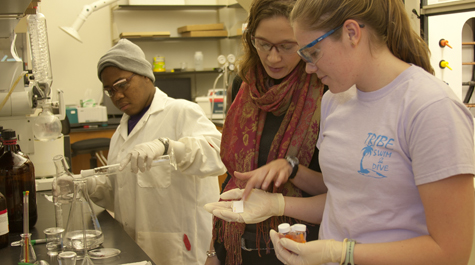Award recognizes student-faculty research excellence, funds new projects
William & Mary’s Elizabeth Harbron is one of six U.S. chemists to be named Henry Dreyfus Teacher-Scholars. The award recognizes chemistry faculty who not only are accomplished researchers themselves, but who also incorporate undergraduate students into their research.
“Research support at undergraduate institutions is very important,” states Mark J. Cardillo, executive director of The Camille and Henry Dreyfus Foundation, in a press release announcing the awards. “Nearly half the chemists who earn a doctorate degree receive their bachelor’s degree from an undergraduate institution. And research is a fundamental part of chemistry education.”
The Henry Dreyfus Teacher-Scholar Award carries a $60,000 unrestricted research grant for each recipient. Harbron, associate professor in William & Mary’s Department of Chemistry, will use the grant to pursue research into a number of rhodamine spirolactam dyes, molecules that show promise in applications as fluorescent sensors. The projects involve a number of William & Mary students.
“This research is based on some molecules we started playing with a little over a year ago in my lab. Like other molecules we use in my lab, these have two forms,” she explained. “In one form they are completely white—essentially colorless. But when they come into contact with the right stimulus —this could be acid or a metal ion—then they undergo a molecular transformation that causes them to become incredibly brightly colored and fluorescent. ”
The Dreyfus award will allow Harbron and her lab to investigate two different aqueous sensor projects. “Any time you have something colorless until it meets something else, you have the potential for a sensor,” she says. One project is focusing on spirolactams that could be used, in concert with some polymer nanoparticles, to detect the presence of mercury in water.
Undergraduates in the lab
Clare LeGuyader ’11 has been working in Harbron’s lab synthesizing new rhodamine spirolactams that respond to mercury ions for her chemistry Honors research. Harbron says Desmarie Sherwood ’13 is learning the ropes so she can take over after LeGuyader graduates. The mercury project also includes Beth Childress ’12, who makes the polymer nanoparticles that are the other component of the mercury sensor system. Harbron notes that the nanoparticles used in the mercury sensor project were originally pioneered in her lab by Christina Davis ’10.
The idea is to investigate the potential for a sensing device that would indicate the presence of increasing concentrations in water by the colors and fluorescence of the spirolactam dyes reacting with the mercury ions dissolved in the water. Harbron says that the activated molecules range in color through various pinks and purples, including fuscias, magentas and other highly distinguishable shades. The second program centers on developing a spirolactam-based sensor system to determine pH, or the relative acidity/alkalinity of water, through a change of color. “In theory, you could line up several of these and have a large variation of fluorescent color over a small pH range,” she explained.
“Becca Allred ’10 was the first student in my lab to begin working with rhodamine spirolactam dyes as pH sensors,” Harbron said. “She used them as part of her 2009-2010 Honors project, and her results were interesting enough that I wanted to keep working with the dyes after she graduated.”
Courtney Roberts ’11 essentially took over the project after Allred graduated, although Harbron noted the work has “changed and mutated as we have learned more about the dyes and how to make them and work with them.” Roberts is continuing the work on the pH-responsiveness of the dyes as part of her Honors research.
11 students as coauthors
Harbron, associate professor in the William & Mary Department of Chemistry, was nominated for the award by department Chair Christopher Abelt. In his letter of nomination, he pointed out that Harbron’s research group is the most popular among students concentrating in chemistry at William & Mary.
“Prof. Harbron incorporates many student coworkers into her research projects,” Abelt wrote. “Eleven students have appeared as coauthors on her publications. On average, four students graduate from her lab each year. Since most of her students work with her for at least four semesters, she mentors nearly ten students researchers over the academic year.”
In support of her nomination, Harbron put together a summary of the her research as well as a funding proposal for the spirolactam projects. Her lab had already been working on aspects of the work, and she says that she and the students have established proof of concept, “but we want to get further along before we publish it.” She noted that Roberts and LeGuyader worked together on the mercury-responsive dyes in her lab throughout the summer of 2010.
“This award is really a testimony to the accomplishments of my students,” she said. “Beth, Courtney, and Clare were responsible for obtaining the preliminary data that went into the grant proposal.”
Harbron is also the interim director for William & Mary’s Murray Scholars Program, an initiative that recruits the nation’s best high school students to William & Mary for a set of closely mentored research-based experience. She won a CAREER award from the National Science Foundation (NSF) in 2007. Her work has been featured in Ideation magazine and in the NSF’s partner web site, LiveScience.
The Camille and Henry Dreyfus Foundation is a leading non-profit organization devoted to the advancement of the chemical sciences. It was established in 1946 by chemist, inventor, and businessman Camille Dreyfus, who directed that the foundation’s purpose be “to advance the science of chemistry, chemical engineering and related sciences as a means of improving human relations and circumstances around the world.”
















